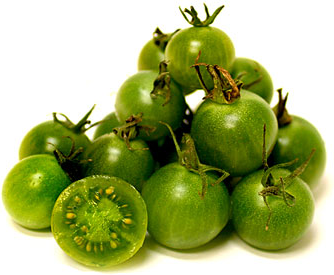


Cherry Green Grape Tomatoes
Estimated Inventory, 12 ct : 0
Description/Taste
Turning an attractive yellowish-green color when ripe, extraordinary green grape tomatoes produce a soft fleshy meat that is unusually sweet.
Seasons/Availability
Green Grape Tomatoes make sporadic appearances throughout the year.
Nutritional Value
Low in calories and cholesterol-free, tomatoes are an excellent source of vitamin C, provide potassium, folate and dietary fiber. Eating five daily servings of fruits and vegetables lowers the chances of cancer. A recent study found that eating nine or ten daily servings of fruits and vegetables, combined with three servings of low-fat dairy products, were effective in lowering blood pressure.
Applications
Toss in mixed greens salads; drizzle with a favorite dressing or vinaigrette. Serve whole with toothpicks, cheese cubes and basil for a simple, healthy, tasty appetizer. Add this tomato darling to stir-fries the last minute of cooking. Slip on kabobs for color and flavor. Basil, thyme, dill weed, parsley, chili powder, bay leaves, mint, curry, oregano and garlic love tomatoes. Use as edible garnish for most anything. For best flavor, serve tomatoes at room temperature.
Ethnic/Cultural Info
Tomatoes are a favored international ingredient in a variety of dishes.
Geography/History
After a lengthy federal trademark dispute over the name "grape tomato" between the original grower and another grower in 1998, it was finally decided that this descriptive generic name would be dedicated to the industry. In their very beginning, tomatoes were not welcomed as an edible food in Europe when introduced by the Spanish conquistadors. Tomatoes were viewed as a very scary member of the Solanceae family, a group that included the spooky nightshade plants. The major reason the tomato experienced major rejection was its uncanny resemblance to a very poisonous and deadly nightshade, Atropus belladonna. Blaming folklore on the tomato's lack of edible popularity, Old German folklore associated nightshade plants with witches and werewolves. The German translation for tomatoes means "wolf peach" which didn't help the tomato's acceptance. However, Carl Linnaeus, known for his naming of species, came to the rescue of the poor tomato in the eighteenth century when he named it Lycopersicon esculentum which means "edible wolf peach".




